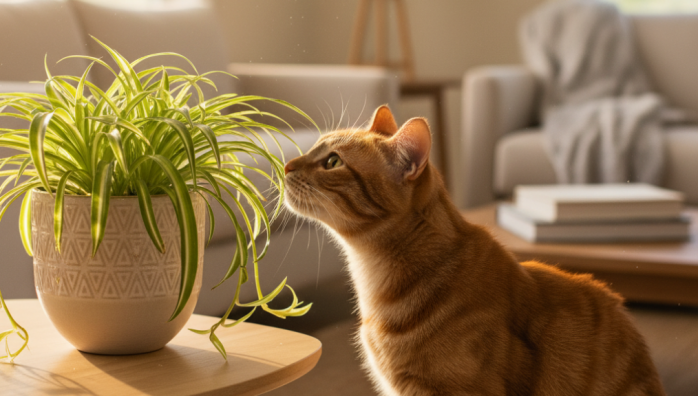Safe Houseplants for Cat Owners
by admin in Pet Care Basics 16 - Last Update November 14, 2025

I'll never forget the sheer panic I felt when I walked into my living room and saw my curious tabby, Leo, chewing on a beautiful lily I had just received as a gift. I had no idea they were lethally toxic to cats. A frantic call to the vet and a stressful 24 hours later, Leo was thankfully fine, but I learned a hard lesson. From that day on, I became obsessed with creating a home that was both a green oasis for me and a completely safe space for my feline companions. It's not about giving up houseplants; it's about choosing the right ones.
Why a cat-safe jungle is non-negotiable for me
For our cats, the world is a playground full of textures and scents to explore, often with their mouths. Unfortunately, many common houseplants, like lilies, Sago Palms, and Dieffenbachia (Dumb Cane), can cause anything from mild irritation to severe organ failure or death. For me, the peace of mind knowing that my cat can't accidentally poison himself is worth more than any trendy but toxic plant. It allows me to enjoy my indoor garden without constantly having to be on high alert.
My personal list of gorgeous and cat-safe houseplants
Over the years, I've filled my home with plants that are both beautiful and completely non-toxic according to the ASPCA. Here are a few of my absolute favorites that have thrived in my home and passed the 'Leo-proof' test.
The spider plant (Chlorophytum comosum)
This is the classic starter plant for pet owners. It's incredibly resilient and produces little 'spiderettes' that are easy to propagate. Cats are often drawn to its dangling leaves, and while it's non-toxic, it can have a mild, harmless hallucinogenic effect on them. I find it's better to let them have their own pot of cat grass to munch on instead, but I don't worry if they bat at this one.
The boston fern (Nephrolepis exaltata)
I love the lush, feathery look of a Boston Fern. It adds a touch of elegance and is perfect for bathrooms or kitchens because it loves humidity. It's completely safe for cats and adds a wonderful texture to your plant collection.
The calathea family (Prayer plants)
If you want a pop of color and pattern, look no further. Calatheas, often called Prayer Plants because their leaves fold up at night, are stunning. I have a Rattlesnake Calathea, and watching its leaves move throughout the day is fascinating. Best of all, they are entirely pet-safe.
The money tree (Pachira aquatica)
With its signature braided trunk, the Money Tree is a popular and stylish choice that's also non-toxic to felines. It's relatively easy to care for and brings a great energy to any room. I keep mine in a spot with bright, indirect light, and it's been a happy resident for years.
The haworthia (Zebra plant)
For those who love the look of succulents but know many (like Aloe Vera) are toxic, the Haworthia is a fantastic alternative. Its striped, spiky appearance is similar to aloe, but it's completely safe for curious cats. It's a low-maintenance gem that I highly recommend.
A final thought on plant safety
Remember, 'non-toxic' doesn't mean 'zero risk of tummy upset.' A cat who eats a large quantity of any plant material might still experience mild vomiting or diarrhea. I've found the best strategy is to provide plenty of other enrichment, like designated cat grass and engaging toys, to redirect their chewing instincts. This list is a great starting point based on my own experience and trusted resources, but I always recommend doing a quick check on the ASPCA's plant list before bringing any new green friend home. It's a simple step that ensures a happy, healthy home for everyone.









